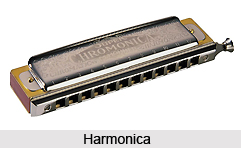 The harmonica is a free reed wind instrument. These flat reed instruments were first developed in the West in the late eighteenth century The German instrument maker, Christian Friedrich Buschmann, built the first mouth-organ in 1821. Matthias Hohner, founder of the Hohner factory, was a former clock-maker who made some improvements to harmonica design and opened a factory to make the instrument in 1857 and improvements.
The harmonica is a free reed wind instrument. These flat reed instruments were first developed in the West in the late eighteenth century The German instrument maker, Christian Friedrich Buschmann, built the first mouth-organ in 1821. Matthias Hohner, founder of the Hohner factory, was a former clock-maker who made some improvements to harmonica design and opened a factory to make the instrument in 1857 and improvements.
The harmonica originally had a wooden frame but nowadays the frame is made of plastic. The basic parts of the harmonica are the combs, the reed plates and the cover plates. The comb is the term for the main body of the instrument which contains the air chambers that cover the reeds. Reed-plate is the term for a grouping of several reeds in a single housing. The reeds are usually made of brass, but steel, aluminum and plastic are occasionally used. There are two rows of small square holes, attached to a voice-plate to which are riveted small reeds or tongues of varying lengths, tuned to the desired pitch. The rows of reeds have curved metal covers attached above and below them. Cover plates cover the reed-plates and are usually made of metal, though wood and plastic have also been used. The kind of material used determines the tonal quality o the harmonica. The mouthpiece is placed between the air chambers of the instrument and the player`s mouth. It can be integrated with the comb or part of the cover or a separate unit entirely.
The mouth-organ is an instrument than can be tuned to various keys, and sucking and blowing produce different notes. It is usually impossible to play a chromatic scale, however, as most mouth-organs are diatonically tuned, but the chromatic scale can be played if a slider is fitted to the instrument. In the 1930s there was some complete mouth-organ or harmonica orchestras in which all parts, including the bass, were played on harmonicas. It was an impressive sight as the higher voices played their instruments in a star formation.
The harmonica is played by blowing air into it or drawing air out by placing lips over individual holes (reed chambers) or multiple holes. The pressure caused by blowing or drawing air into the reed chambers causes a reed or multiple reeds to vibrate up and down creating sound. Each chamber has multiple, variable-tuned brass or bronze reeds which are secured at one end and loose on the other end, with the loose end vibrating and creating sound. Reeds are pre-tuned to individual tones, and each tone is determined according to the size of reed. Longer reeds make deep, low sounds and short reeds make higher-pitched sounds. On certain types of harmonica the pre-tuned reed can be changed (bending a note) to another note by redirecting air flow into the chamber. There are many types of harmonicas, including diatonic, chromatic, tremolo, orchestral, and bass versions.
Alternatively called the mouth organ, blues harp and French harp, the harmonica is most often used in blues and American folk music, jazz, country music and rock and roll. In India, the harmonica has been used quite often in Indian film music.




















